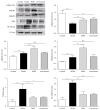Bushenkangshuai Tablet Reduces Atherosclerotic Lesion by Improving Blood Lipids Metabolism and Inhibiting Inflammatory Response via TLR4 and NF- κ B Signaling Pathway
- PMID: 29619063
- PMCID: PMC5829360
- DOI: 10.1155/2018/1758383
Bushenkangshuai Tablet Reduces Atherosclerotic Lesion by Improving Blood Lipids Metabolism and Inhibiting Inflammatory Response via TLR4 and NF- κ B Signaling Pathway
Abstract
Bushenkangshuai tablet (BSKS) is a Chinese herbal compound which has been used for the treatment of cardiovascular and cerebrovascular diseases in China for decades. This study intends to explore the molecular mechanism of BSKS against atherosclerosis in ApoE-/- mice. ApoE-/- mice were fed with western-type diet for 6 weeks and then were given BSKS for 6 weeks. The results showed that BSKS attenuated the size of the atherosclerotic lesion, reduced visceral adipose content, and decreased blood lipids. We also found that BSKS promoted the expression of adiponectin and its receptors, inhibited the expression of Toll-like receptor 4 and nuclear factor-kappa B, decreased the levels of interleukin-1 beta, monocyte chemotactic protein-1, and vascular cell adhesion molecule-1, and increased the levels of interleukin-10 and adiponectin. Our data provided evidence that BSKS exerted an antiatherosclerotic effect by lowering blood lipids and inhibiting inflammatory response via TLR4 and NF-κB signaling pathway.
Figures




Similar articles
-
BuShenKangShuai Tablet Alleviates Hepatic Steatosis via Improving Liver Adiponectin Resistance in ApoE-/- Mice.Evid Based Complement Alternat Med. 2019 Feb 13;2019:8986038. doi: 10.1155/2019/8986038. eCollection 2019. Evid Based Complement Alternat Med. 2019. PMID: 30894877 Free PMC article.
-
New role of PCSK9 in atherosclerotic inflammation promotion involving the TLR4/NF-κB pathway.Atherosclerosis. 2017 Jul;262:113-122. doi: 10.1016/j.atherosclerosis.2017.04.023. Epub 2017 Apr 29. Atherosclerosis. 2017. PMID: 28535426
-
Efficacy of Shoushen granule on adenosine triphosphate binding cassette transporter A1, proprotein convertase subtilisin/kexin type 9 and toll-like receptor 4/nuclear factor kappa-B signaling pathway in ApoE-knockout mice.J Tradit Chin Med. 2019 Aug;39(4):524-534. J Tradit Chin Med. 2019. PMID: 32186100
-
Anti-atherosclerotic effects of Polygonum aviculare L. ethanol extract in ApoE knock-out mice fed a Western diet mediated via the MAPK pathway.J Ethnopharmacol. 2014 Feb 12;151(3):1109-1115. doi: 10.1016/j.jep.2013.12.021. Epub 2013 Dec 24. J Ethnopharmacol. 2014. PMID: 24370878
-
[Regulatory effect of Di'ao Xinxuekang on TLR4/MyD88/NF-κB signaling pathway in atherosclerotic rats].Zhongguo Zhong Yao Za Zhi. 2020 Feb;45(3):602-608. doi: 10.19540/j.cnki.cjcmm.20190827.402. Zhongguo Zhong Yao Za Zhi. 2020. PMID: 32237519 Chinese.
Cited by
-
BuShenKangShuai Tablet Alleviates Hepatic Steatosis via Improving Liver Adiponectin Resistance in ApoE-/- Mice.Evid Based Complement Alternat Med. 2019 Feb 13;2019:8986038. doi: 10.1155/2019/8986038. eCollection 2019. Evid Based Complement Alternat Med. 2019. PMID: 30894877 Free PMC article.
References
-
- Smith S. R., Lovejoy J. C., Greenway F., et al. Contributions of total body fat, abdominal subcutaneous adipose tissue compartments, and visceral adipose tissue to the metabolic complications of obesity. Metabolism - Clinical and Experimental. 2001;50(4):425–435. doi: 10.1053/meta.2001.21693. - DOI - PubMed
-
- Hansen T., Ahlström H., Söderberg S., et al. Visceral adipose tissue, adiponectin levels and insulin resistance are related to atherosclerosis as assessed by whole-body magnetic resonance angiography in an elderly population. Atherosclerosis. 2009;205(1):163–167. doi: 10.1016/j.atherosclerosis.2008.11.007. - DOI - PubMed
LinkOut - more resources
Full Text Sources
Other Literature Sources
Research Materials
Miscellaneous

